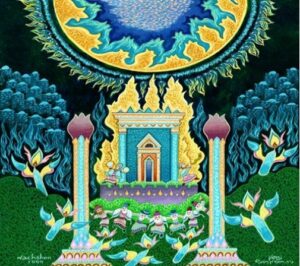בס”ד
By Rabbi Moshe Goodman, Kollel Ohr Shlomo, Hebron

This parsha begins with the obligation to have fire burning at the altar in the Temple. This painting
highlights the fire at the Temple, depicting the entire Temple as a burning fire apparently awakening a
supernal fire above depicted as a sphere of fire. Also below the Temple there are candles of fire depicted
as angelic-winged figures, in the midst of two candles,which are a clear allusion to the Shabbat candles.
There are also seven dancing hasidim below, and two hasidim playing instruments above next to the
Temple. It seems that this parallelism between the candles and the hasidim hints to the verse “the candle
of Hashem is the soul of man.” Kabbalistically, it seems that the seven dancing hasidim/candles hint to
the seven lower sefirot considered one group, while the two music-playing hasidim/large candles along
with the burning Temple, which hints to a third aspect of the “Holy Presence,” hint to the three upper
sefirot of Keter Hochma and Bina. The Holy Presence can be indeed considered a “tenth aspect” as we see
from the teaching of the Zohar that the Shechina adjoined to the nine brothers to make a minyan in the
sale of Yosef (since Reuven and Binyamin were absent). The two music-playing hasidim essentially are a
cause to the dancing of the seven hasidim just as Hochma and Bina are considered the”cause” of the seven
lower sefirot, and of course the cause of all this is the Holy Presence at the Temple, corresponding to
Keter. Also notice how the upper sphere touches the Temple, and this upper sphere contains what look like
“crowns of pomegranates in fire.” The allusion of the large candllesticks to the candles of Shabbat seems
to hint to the teaching of our Sages: “if you light the lights of Shabbat I shall show you the lights of Zion.”
Indeed, we also see the city of Zion/Jerusalem surrounding the Temple in bluish flames. The colors seen
here seem to indicate the colors of the Mishkan, forerunner of the Temple: yellow found in gold, white in
silver andlinen, brown in copper, purple in the argaman, blue in the techelet, red in scarlet, black in goat’s
skin.
Below all this is the green grass/land of the Holy Land, for all also the Temple stems from the holiness of
the Holy Land as the mishna of Kelim says that there are ten sanctifications of location beginning with the
Holy Land and leading up to the Holy of Holies in the Temple. This may also allude to the power of
Hebron, Beacon of the Holy Land, which also means unity, a concept associated with the sefira of tiferet
which is also associated with the color of green.



